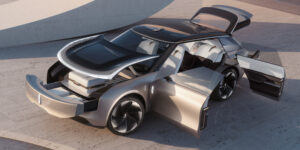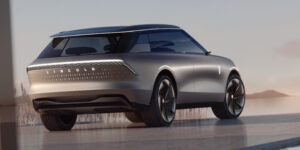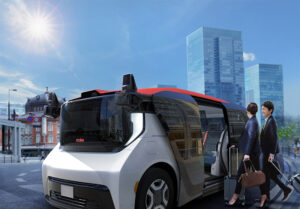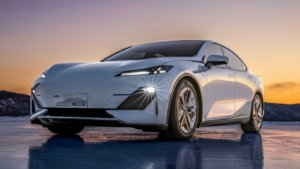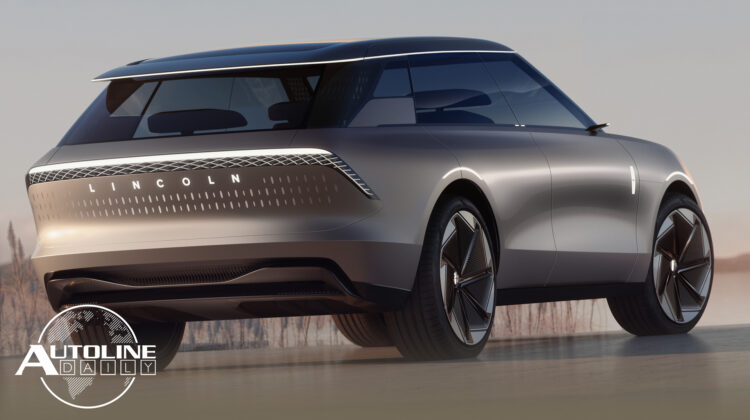
Listen to “AD #3308 – Musk Downplays 800v EVs; Lincoln's Glorious EV Concept; Honda to Use GM's Cruise Origin in Japan” on Spreaker.
Follow us on social media:
Runtime: 11:06
0:07 Tesla Posts Record Sales, Revenue & Profit
1:19 Highlights from Tesla’s Earnings Call
4:58 Lincoln’s Glorious EV Concept
8:21 Honda to Use GM’s Cruise Origin in Japan
8:54 Euro NCAP Goes Green
9:53 Changan Builds China’s First Fuel Cell Car
Visit our sponsors to thank them for their support of Autoline Daily: Bridgestone, Intrepid Control Systems and Schaeffler.
This is Autoline Daily, the show dedicated to enthusiasts of the global automotive industry.
TESLA POSTS RECORD SALES, REVENUES & PROFITS
Tesla reported its first quarter earnings and the numbers are stunningly good despite supply chain bottlenecks around the world, an industry-wide chip shortage, Covid lockdowns in China and a war raging on in Ukraine. Despite all that, Tesla managed to boost its sales 68% compared to a year ago. It sold over 310,000 cars. That brought in nearly $17 billion of automotive revenue, which represents a staggering 87% increase over last year. Total revenue, including solar panels and storage, came to nearly $19 billion. And $3.3 billion of that ended up on the bottom line, which was up a ridiculous 658% compared to last year. Even compared to the prior quarter, profits were up 43%.
Here’s our Autoline Insight. Tesla is turning into a money machine. And with new assembly plants coming on stream in Berlin and Texas, we believe it’s going to outperform all these numbers in the quarters to come.
MUSK DOWNPLAYS 800v EVS
And here are some surprising nuggets of information that we dug out of the earnings call that Elon Musk had with Wall Street analysts. This one caught us by surprise. Tesla doesn’t see any reason to use an 800 volt architecture in its cars.
“Let me just quantify that. Basically, our estimate is that going from 400 to 800 volts might save $100. It’s not really moving the needle.”
Elon said that 800 volt architectures make sense in very big vehicles, like the Semi and Cybertruck, but not in the 3, the Y or the S and X.
WHY TESLA IS RAISING PRICES SO MUCH
He also explained why they’ve been raising prices so much.
“Actually, on the price increase front, I should mention that it may seem like maybe we’re being unreasonable about increasing the prices of our vehicles, given that we had record profitability this quarter, but the wait list for our vehicles is quite long. And some of the vehicles that people will order, the wait list extends into next year. So, our prices of vehicles ordered now are really anticipating supplier and logistics cost growth that we’re aware of and believe will happen over the next 6 to 12 months.”
In other words, Tesla is raising prices now because by the time people take delivery of their cars, the raw materials needed to make them will be more expensive. So it’s protecting itself from higher costs in the future, not just what it’s seeing now.
ROBOTAXIS CHEAPER THAN BUS RIDES
Musk also talked a lot about driving down the cost of mobility and not just with cheaper EVs. He really sees the solution as robotaxis.
“I mean, looking at some of our projections, it would appear that a robotaxi ride will cost less than a bus ticket, a subsidized bus ticket or subsidized subway ticket.”
TESLA INSURANCE OFFERS BIG ADVANTAGES
And finally, Musk talked about the advantages of Tesla providing insurance to its customers. He says they can offer lower rates and a much better experience.
“And basically, the customer experience is just vastly better because if there’s an accident, there’s no argument. We’ll repair it immediately. And this is as compared to arguing with an insurance company and then a claims adjuster and then a collision repair center. And this can be a nightmare basically. So we’re trying to turn a nightmare into a dream with Tesla Insurance.”
I think most people would agree that dealing with insurance companies can be a headache, so Tesla could have a real advantage there. It expects 80% of its customers in the U.S. to buy car insurance from Tesla rather than go with a traditional insurance company.
LINCOLN’S GLORIOUS EV CONCEPT
We’re not sure if the new Lincoln Star Concept that debuted after yesterday’s show is a vehicle or a transformer? I’m joking, of course, but look how the rear tailgate folds down and transforms into a bench to sit on with additional storage behind the rear seats. And the hood raises up and the grille extends out to reveal extra storage and a pass through into the interior. And it, too, transforms.
The front seats can swivel around to face the rear seat passengers. While this is cool, we expect stuff like this to stay in concept land. But the Star Concept also hints at the design language for future electric vehicles. And Lincoln says it will have four new ones by 2026. Lighting is clearly going to play a key role in its future designs. Not only does it have a more expressive lighting display for the traditional front and rear lamps, it also uses lighting to accent the badging, wheel arches, roofline and even what looks like some sort of autonomous sensor on the roof. And with front seats that swivel, it would make a lot of sense that the Star Concept would be autonomous. I want to highlight the rear as well. Note how all the lines kind of flow down and pinch together. It creates a unique look with the beltline, which is uninterrupted all the way to the back of the vehicle, the body color never breaks and goes up into the rear pillar. And the way it comes to a point a little reminiscent of the Kia EV6.
Last thing I want to talk about is inspired by an email I got yesterday, shout out to Grayson, asking what’s with all the two-spoke steering wheels? Is it a luxury thing? It’s on the BMW i7, Lucid Air, Hyundai IONIQ 5, etc. Not only do luxury vehicle designers seem to like the aesthetic, but I think it’s got more to do with these large displays that blend multiple screens together into one unit. A two-spoke steering wheel makes it easier to see the screen and it’s a feature that all these vehicles have.
ROB DICKINSON OF SINGER DESIGN ON AFTER HOURS
Have you ever heard of Singer Vehicle Design? It’s a California company that customizes air-cooled Porsches, with an attention to detail that can transform 911s into works of art. Rob Dickinson the founder of Singer is our guest on Autoline After Hours today. He’s an interesting guy. Before he started the company he was in an alternative rock band. So how do you go from rocker to world famous car customizer? Join us this afternoon at 3 PM to find out.
HONDA TO USE GM’s CRUISE ORIGIN IN JAPAN
We already knew that Honda will use GM’s Ultium platform for its electric vehicles, and it’s also getting that autonomous shuttle called the Origin that’s being developed by GM Cruise. And Honda signed a memorandum of understanding with two Japanese transportation service providers to launch autonomous mobility services in Tokyo in the middle of the decade using the Origin. Honda didn’t provide any other details but to us it’s cool to see a vehicle that will be built in Detroit being put to use like this in Japan.
EURO NCAP GOES GREEN
The European New Car Assessment Program, or Euro NCAP, evaluates and crash tests new vehicles for safety. And now it created a new category: Green NCAP. It’s all about promoting the development of environmentally friendly vehicles. And it just released its first Life Cycle Assessment or “cradle-to-grave” report that looks at the environmental impact of the top selling vehicles in Europe. The study looked at 61 cars of all types from 2019 to 2021 and assumed a lifetime of 16 years and 240,000 kilometers driven or nearly 150,000 miles. But it says the report is intended for informational purposes only and doesn’t rank the vehicles from best to worst. The intent is to highlight the importance of adopting an approach that takes into account the life cycle impact of cars on the environment.
CHANGAN BUILDS CHINA’S FIRST FUEL CELL CAR
Chinese automaker Changan Auto is making a bit of history and will be the first Chinese brand to mass produce a fuel cell vehicle. Called the C385, it’s being launched under Changan’s new Shenlan EV brand. The model, which goes on sale in the second half of the year, actually comes with three powertrains; BEV, plug-in hybrid or fuel cell. The BEV and fuel cell have a range of 700 kilometers or 435 miles. And the PHEV has a total range of 1,200 kilometers or 745 miles. And while the article didn’t indicate, those numbers are likely based on the easier WLTP or NEDC tests.
But that’s a wrap for today. Thanks for joining us.
Thanks to our partner for embedding Autoline Daily on its website: WardsAuto.com
Seamus and Sean McElroy cover the latest news in the automotive industry for Autoline Daily.






